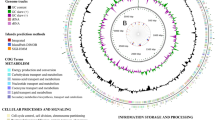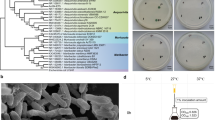Abstract
Bacteria of the genus Photobacterium thrive worldwide in oceans and show substantial eco-physiological diversity including free-living, symbiotic and piezophilic life styles. Genomic characteristics underlying this variability across species are poorly understood. Here we carried out genomic and physiological analysis of Photobacterium phosphoreum strain ANT-2200, the first deep-sea luminous bacterium of which the genome has been sequenced. Using optical mapping we updated the genomic data and reassembled it into two chromosomes and a large plasmid. Genomic analysis revealed a versatile energy metabolic potential and physiological analysis confirmed its growth capacity by deriving energy from fermentation of glucose or maltose, by respiration with formate as electron donor and trimethlyamine N-oxide (TMAO), nitrate or fumarate as electron acceptors, or by chemo-organo-heterotrophic growth in rich media. Despite that it was isolated at a site with saturated dissolved oxygen, the ANT-2200 strain possesses four gene clusters coding for typical anaerobic enzymes, the TMAO reductases. Elevated hydrostatic pressure enhances the TMAO reductase activity, mainly due to the increase of isoenzyme TorA1. The high copy number of the TMAO reductase isoenzymes and pressure-enhanced activity might imply a strategy developed by bacteria to adapt to deep-sea habitats where the instant TMAO availability may increase with depth.





Similar content being viewed by others
Abbreviations
- TMAO:
-
Trimethylamine N-oxide
- CDS:
-
Coding DNA sequence
References
Abe F, Kato C, Horikoshi K (1999) Pressure-regulated metabolism in microorganisms. Trends Microbiol 7:447–453
AlAli B, Garel M, Cuny P, Miquel JC, Toubal T, Robert A, Tamburini C (2010) Luminous bacteria in the deep-sea waters near the ANTARES underwater neutrino telescope (Mediterranean Sea). Chem Ecol 26:57–72
Ansaldi M, Simon G, Lepelletier M, Mejean V (2000) The TorR high-affinity binding site plays a key role in both torR autoregulation and torCAD operon expression in Escherichia coli. J Bacteriol 182:961–966
Ansaldi M, Jourlin-Castelli C, Lepelletier M, Theraulaz L, Mejean V (2001) Rapid dephosphorylation of the TorR response regulator by the TorS unorthodox sensor in Escherichia coli. J Bacteriol 183:2691–2695
Armengaud J, Trapp J, Pible O, Geffard O, Chaumot A, Hartmann EM (2014) Non-model organisms, a species endangered by proteogenomics. J Proteomics 105:5–18
Ast JC, Dunlap PV (2005) Phylogenetic resolution and habitat specificity of members of the Photobacterium phosphoreum species group. Environ Microbiol 7:1641–1654
Bordi C, Ansaldi M, Gon S, Jourlin-Castelli C, Iobbi-Nivol C, Mejean V (2004) Genes regulated by TorR, the trimethylamine oxide response regulator of Shewanella oneidensis. J Bacteriol 186:4502–4509
Campanaro S et al (2005) Laterally transferred elements and high pressure adaptation in Photobacterium profundum strains. BMC Genomics 6:122
Christie-Oleza JA, Fernandez B, Nogales B, Bosch R, Armengaud J (2012) Proteomic insights into the lifestyle of an environmentally relevant marine bacterium. ISME J 6:124–135
Dryselius R, Kurokawa K, Iida T (2007) Vibrionaceae, a versatile bacterial family with evolutionarily conserved variability. Res Microbiol 158:479–486
El-Hajj ZW, Allcock D, Tryfona T, Lauro FM, Sawyer L, Bartlett DH, Ferguson GP (2010) Insights into piezophily from genetic studies on the deep-sea bacterium, Photobacterium profundum SS9. Ann N Y Acad Sci 1189:143–148
Eloe EA, Lauro FM, Vogel RF, Bartlett DH (2008) The deep-sea bacterium Photobacterium profundum SS9 utilizes separate flagellar systems for swimming and swarming under high-pressure conditions. Appl Envionment Microbiol 74:6298–6305
Frankel RB, Bazylinski DA, Johnson MS, Taylor BL (1997) Magneto-aerotaxis in marine coccoid bacteria. Biophys J 73:994–1000
Genest O, Ilbert M, Mejean V, Iobbi-Nivol C (2005) TorD, an essential chaperone for TorA molybdoenzyme maturation at high temperature. J Biol Chem 280:15644–15648
Le Bihan T, Rayner J, Roy MM, Spagnolo L (2013) Photobacterium profundum under pressure: a MS-based label-free quantitative proteomics study. PLoS One 8:e60897
Martini S et al (2013) Effects of hydrostatic pressure on growth and luminescence of a moderately-piezophilic luminous bacteria Photobacterium phosphoreum ANT-2200. PLoS One 8:e66580
Okada K, Iida T, Kita-Tsukamoto K, Honda T (2005a) Vibrios commonly possess two chromosomes. J Bacteriol 187:752–757
Okada K, Iida T, Kita-Tsukamoto K, Honda T (2005b) Vibrios commonly possess two chromosomes. J Bacteriol 187:752–757
Ruan J et al (2012) Architecture of a flagellar apparatus in the fast-swimming magnetotactic bacterium MO-1. Proc Natl Acad Sci USA 109:20643–20648
Santini CL, Ize B, Chanal A, Muller M, Giordano G, Wu LF (1998) A novel sec-independent periplasmic protein translocation pathway in Escherichia coli. EMBO J 17:101–112
Simon G, Jourlin C, Ansaldi M, Pascal MC, Chippaux M, Mejean V (1995) Binding of the TorR regulator to cis-acting direct repeats activates tor operon expression. Mol Microbiol 17:971–980
Tamburini C et al (2013) Deep-sea bioluminescence blooms after dense water formation at the ocean surface. PLoS One 8:e67523
Urbanczyk H et al (2011) Genome sequence of Photobacterium mandapamensis strain svers.1.1, the bioluminescent symbiont of the cardinal fish Siphamia versicolor. J Bacteriol 193:3144–3145
Vallenet D et al (2013) MicroScope–an integrated microbial resource for the curation and comparative analysis of genomic and metabolic data. Nucleic Acids Res 41:D636–D647
Vezzi A et al (2005) Life at depth: Photobacterium profundum genome sequence and expression analysis. Science 307:1459–1461
Wang F et al (2008) Environmental adaptation: genomic analysis of the piezotolerant and psychrotolerant deep-sea iron reducing bacterium Shewanella piezotolerans WP3. PLoS One 3:e1937
Welch TJ, Bartlett DH (1998) Identification of a regulatory protein required for pressure-responsive gene expression in the deep-sea bacterium Photobacterium species strain SS9. Mol Microbiol 27:977–985
Yancey PH, Clark ME, Hand SC, Bowlus RD, Somero GN (1982) Living with water stress: evolution of osmolyte systems. Science 217:1214–1222
Yancey PH, Blake WR, Conley J (2002) Unusual organic osmolytes in deep-sea animals: adaptations to hydrostatic pressure and other perturbants. Comp Biochem Physiol A: Mol Integr Physiol 133:667–676
Yancey PH, Gerringer ME, Drazen JC, Rowden AA, Jamieson A (2014) Marine fish may be biochemically constrained from inhabiting the deepest ocean depths. Proc Natl Acad Sci USA 111:4461–4465
Zhang WJ et al (2012) Complex spatial organization and flagellin composition of flagellar propeller from marine magnetotactic ovoid strain MO-1. J Mol Biol 416:558–570
Zhang SD et al (2014a) Genome sequence of luminous piezophile Photobacterium phosphoreum ANT-2200. Genome Announc 2:e00096–14
Zhang SD et al (2014b) Swimming behaviour and magnetotaxis function of the marine bacterium strain MO-1. Environ Microbiol Rep 6:14–20
Acknowledgments
This work was supported by Grants SIDSSE-201307, SIDSSE-QN-201405, SIDSSE-QN-201406 and SIDSSE-QN-201408 from Sanya Institute of Deep-Sea Sciences and Engineering, the Strategic Priority Research Program grant XDB06010203 and International Partnership for Innovative Team Program (20140491526) from the Chinese Academy of Sciences, the NSFC 41506147 from National Natural Science Foundation of China, a grant for LIA-BioMNSL from Centre National de la Recherche Scientifique, the grant DY125-15-R-03 from China Ocean Mineral Resources R & D Association (COMRA) Special Foundation, the Grant NSFC 41306161 from the National Science Foundation of China and a grant from Mt. Tai Scholar Construction Engineering Special Foundation of Shandong Province. We acknowledge France Genomique for the support for this sequencing project.
Author information
Authors and Affiliations
Corresponding author
Additional information
Communicated by H. Atomi.
Electronic supplementary material
Below is the link to the electronic supplementary material.
Rights and permissions
About this article
Cite this article
Zhang, SD., Santini, CL., Zhang, WJ. et al. Genomic and physiological analysis reveals versatile metabolic capacity of deep-sea Photobacterium phosphoreum ANT-2200. Extremophiles 20, 301–310 (2016). https://doi.org/10.1007/s00792-016-0822-1
Received:
Accepted:
Published:
Issue Date:
DOI: https://doi.org/10.1007/s00792-016-0822-1




